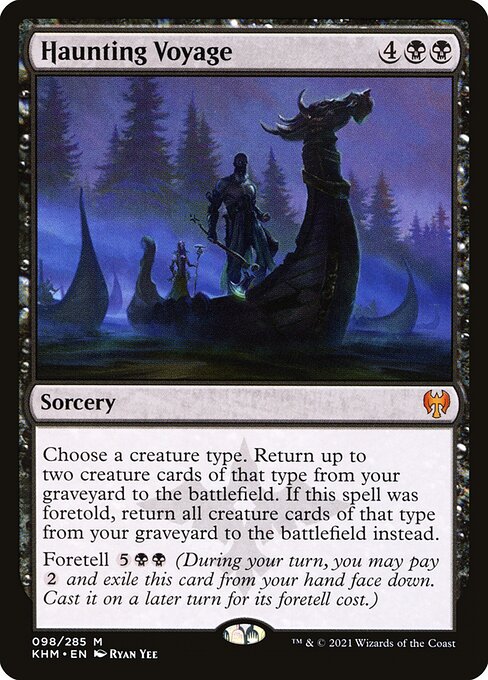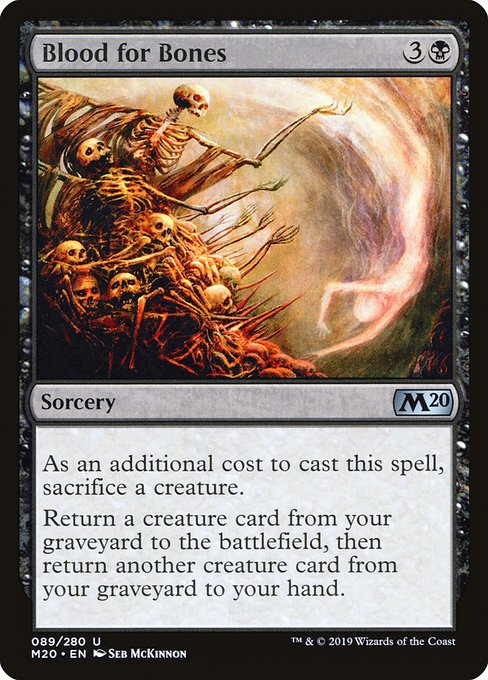Once you free yourself from caring about your rank in Arena, you can really explore the possibilities. In the last couple of weeks, I’ve gone 2-14 with a Standard Sultai Reanimator deck.
What have I learned? It’s much easier just to ramp to Koma, Cosmic Serpent, or run Yorion-Ultimatum than it is to jump through the hoops necessary to discard and reanimate a threat in the current format. Add to that the ubiquity of Elspeth’s Nightmare, Cling to Dust, and Ugin, and you’re looking at a quixotic little failure of a deck. Nullpriest of Oblivion performed better than expected, though. Early on, it bites removal after buffing your life total a bit, and later on gets extra value as a Zombify and a +1/+1 counter vehicle. But aside from that, the deck was a complete debacle.

From there, I tried a Dragon Reanimator deck with Haunting Voyage. While this deck worked much better, it was completely overkill. Spending early turns setting up in the hopes of getting off a turn seven Voyage to bring back a couple of Goldspan Dragons and Terror of the Peaks is less attractive than just casting the Goldspan Dragons on turn five and six. Magic’s current crop of threats vastly outstrips the benefits of reanimation (without a cheap Reanimate or Goryo’s Vengeance). So I scrapped Rakdos Reanimator and went back to Kroxa piles, and suddenly began ranking up.
My failed experiments did get me thinking about the archetype again in Historic, though—although the graveyard removal is an even more serious issue in the broader format, last week brought a few crucial pieces in Historic Anthology 5: Grisly Salvage as an enabler and the Praetors as reanimation targets. The issues I had with the Standard reanimators was that—Vorinclex aside—they didn’t present enough immediate pressure and generally wound up going Extinct. The Praetors, though, either lock your opponent out or wipe their hand or board, and are all threats. Here’s the deck I’ve been running:
Historic Reanimator
The perfect draw is turn one Thoughtseize or Stitcher’s Supplier, turn two Grisly Salvage (finding Unburial Rites and any Praetor), turn four Unburial Rites. I’m still tuning the ratio of enablers to threats to mill—so far, I’ve ended up casting Elesh Norn almost as frequently as I reanimate her. Reanimator deckbuilding requires careful calibration; playing the deck requires a willingness to mulligan to four and hope for a miracle.
We’re missing some velocity in our mill and discard—Stitcher’s Supplier is great, but a repeatable, beneficial mill tool would help us a lot. I have hope Liliana, the Last Hope will serve that role when she inevitably is printed into Historic. Other Eldritch Moon standout Collective Brutality would also be a boon and is likely to eventually hit the Historic pool. We need something to allow us to discard any Praetors we draw for our benefit.
You sometimes run into a discard or mill deck in the Historic queues, and the smoothness of those games is comical compared to the clunkiness of the deck against, say, control. I’ve been using Rotting Regisaur for early discard (and as a respectable threat in its own right), but something that disrupts the opponent’s gameplan while furthering yours would be better. Above all, it’s very susceptible to commonly-played sideboard cards—particularly Ashiok, Grafdigger’s Cage, and Relic of Progenitus. Culling Ritual helps against the Cage and cleans up other troublesome permanents, while not affecting you adversely.

There’s definitely an iteration of this deck that’s more based on Blood for Bones that runs Eyetwitch and Stitcher’s Supplier and seeks to reanimate something on turn four, rather than running the quasi-Dredge self-mill plan that Grisly Salvage and Witherbloom Command offer. This deck lacks the creature density to run Blood for Bones, though, and Eyetwitch is a pretty awful top deck in almost all situations.
I don’t think the deck is quite ready for actual events, although it’s been a blast to play in the best-of-three queues. It’s a turn too slow, and it falls victim to the classic Reanimator problem of drawing your threats and being forced to mulligan aggressively. That said, as someone who played Unburial Rites back in Innistrad Standard, it feels good to break an Elesh Norn out of the graveyard again.
While I wouldn’t recommend this deck for an Arena Open or if you’re desperate to get that Mythic rank this month, it’s a great choice for when the Historic metagame gets stagnant. There’s little better than landing an early Elesh Norn against mono-Red and watching them realize all their creatures are dead on arrival, or seeing an opponent’s turn one Ruin Crab and quietly thanking them for turbocharging your deck. That’s the beauty of a reanimator deck: exhuming the big things makes you appreciate the small things all the more.
A lifelong resident of the Carolinas and a graduate of the University of North Carolina, Rob has played Magic since he picked a Darkling Stalker up off the soccer field at summer camp. He works for nonprofits as an educational strategies developer and, in his off-hours, enjoys writing fiction, playing games, and exploring new beers.

